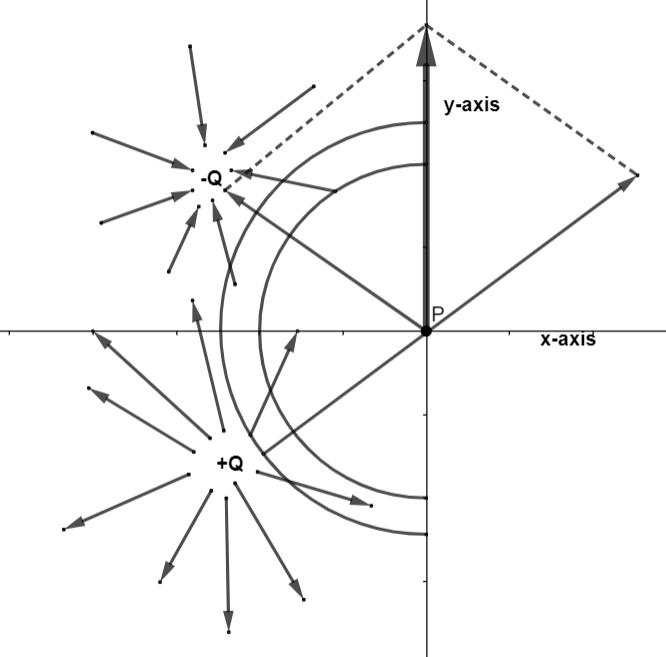
Find the direction of the electric field at a point P for the change distribution as shown in figure.

(a) Along the positive y-axis.
(b) Along the negative y-axis.
(c) Along positive x-axis.
(d) Along negative x-axis.

Answer
482.4k+ views
Hint: We will the basic concept of the resultant forces in the form of a parallelogram. Also, these forces will give directions according to their charges present on them. As there is one positive charge and a negative charge then, the positive one will provide the direction of the electric charge outwards whereas the negative one will be opposite to it.
Complete step by step answer:
Electric field: By the term electric field we mean a kind of electric force that surrounds any substance. Within the area of that field the electric force on a unit charge shows its intensity on a unit charge. The SI unit of the electric field is measured in Newton per coulomb.
As there are two types of charges, one is positive and another one is negative, so these have their respective properties of repelling as well as attracting different objects with a charge. The positive charge has field lines going outwards whereas the field lines of a negative charge is going inwards. If we look at the diagram we will draw out the field lines around the charges then the net resultant force will show us the direction of point P. Since, by the net resultant force we get that it is simply the diagonal of the parallelogram that is formed by the two forces. Since, the diagonal of the parallelogram gives the resultant force as its diagonal so, the direction of the electric field will be in the positive direction of y-axis. This can be understood by the following diagram.

So, the correct answer is “Option A”.
Note: The things to be on your finger tips for further questions like this are,
(1) The electric field lines from a positively charged object will be outwards.
(2) The electric field lines from a negatively charged object will be inwards.
(3) The resultant of the two forces, in any form, will result in the addition of the two forces. If the forces are making a parallelogram then the resultant force will be its diagonal.
(4) If there are two positively charged particles then, the forces will result into the direction of P towards the positive direction of x-axis.
Complete step by step answer:
Electric field: By the term electric field we mean a kind of electric force that surrounds any substance. Within the area of that field the electric force on a unit charge shows its intensity on a unit charge. The SI unit of the electric field is measured in Newton per coulomb.
As there are two types of charges, one is positive and another one is negative, so these have their respective properties of repelling as well as attracting different objects with a charge. The positive charge has field lines going outwards whereas the field lines of a negative charge is going inwards. If we look at the diagram we will draw out the field lines around the charges then the net resultant force will show us the direction of point P. Since, by the net resultant force we get that it is simply the diagonal of the parallelogram that is formed by the two forces. Since, the diagonal of the parallelogram gives the resultant force as its diagonal so, the direction of the electric field will be in the positive direction of y-axis. This can be understood by the following diagram.

So, the correct answer is “Option A”.
Note: The things to be on your finger tips for further questions like this are,
(1) The electric field lines from a positively charged object will be outwards.
(2) The electric field lines from a negatively charged object will be inwards.
(3) The resultant of the two forces, in any form, will result in the addition of the two forces. If the forces are making a parallelogram then the resultant force will be its diagonal.
(4) If there are two positively charged particles then, the forces will result into the direction of P towards the positive direction of x-axis.
Recently Updated Pages
Master Class 12 Economics: Engaging Questions & Answers for Success

Master Class 12 Maths: Engaging Questions & Answers for Success

Master Class 12 Biology: Engaging Questions & Answers for Success

Master Class 12 Physics: Engaging Questions & Answers for Success

Master Class 12 Business Studies: Engaging Questions & Answers for Success

Master Class 12 English: Engaging Questions & Answers for Success

Trending doubts
Which are the Top 10 Largest Countries of the World?

Differentiate between homogeneous and heterogeneous class 12 chemistry CBSE

Draw a labelled sketch of the human eye class 12 physics CBSE

What is the Full Form of PVC, PET, HDPE, LDPE, PP and PS ?

What is a transformer Explain the principle construction class 12 physics CBSE

What are the major means of transport Explain each class 12 social science CBSE




